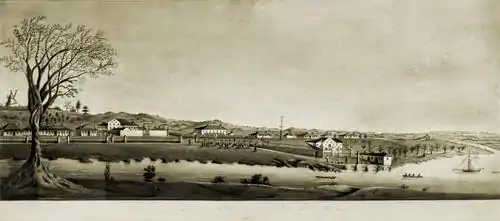History of Brisbane
Brisbane's recorded history dates from 1799, when Matthew Flinders explored Moreton Bay on an expedition from Port Jackson, although the region had long been occupied by the Yugara and Turrbal aboriginal tribes. The town was conceived initially as a penal colony for British convicts sent from Sydney. Its suitability for fishing, farming, timbering, and other occupations, however, caused it to be opened to free settlement in 1838. The town became a municipality in 1859 and a consolidated metropolitan area in 1924. Brisbane encountered major flooding disasters in 1893, 1974 and 2011. Significant numbers of US troops were stationed in Brisbane during World War II. The city hosted the 1982 Commonwealth Games, World Expo 88, and the 2014 G20 Brisbane summit.
Part of a series on the |
||||||||||||||||||||||
|---|---|---|---|---|---|---|---|---|---|---|---|---|---|---|---|---|---|---|---|---|---|---|
| History of Brisbane | ||||||||||||||||||||||
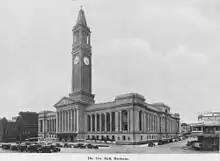 | ||||||||||||||||||||||
| History | ||||||||||||||||||||||
|
||||||||||||||||||||||
Etymology
Brisbane, Queensland, Australia, is named for Sir Thomas Brisbane (1773–1860), British soldier and colonial administrator born in Ayrshire, Scotland. Sir Thomas Brisbane was Governor of New South Wales at the time that Brisbane was named.
Aboriginal history
Prior to European colonisation, the Brisbane region was occupied by Aboriginal tribes, notably clans of the Yugara, Turrbal and Quandamooka peoples. The oldest archeological site in the Brisbane region comes from Wallen Wallen Creek on North Stradbroke Island (21,430±400 years before present), however, settlement would likely occurred well prior to this date.[1]
The land, the river and its tributaries were the source and support of life in all its dimensions. The river's abundant supply of food included fish, shellfish, crab, and prawns. Good fishing places became campsites and the focus of group activities. The district was defined by open woodlands with rainforest in some pockets or bends of the Brisbane River.[2]
A resource-rich area and a natural avenue for seasonal movement, Brisbane was a way station for groups travelling to ceremonies and spectacles. The region had several large (200–600 person) seasonal camps, the biggest and most important located along waterways north and south of the current city heart: Barambin or 'York's Hollow' camp (today's Victoria Park) and Woolloon-cappem (Woolloongabba/South Brisbane), also known as Kurilpa. These camping grounds continued to function well into historic times, and were the basis of European settlement in parts of Brisbane.[3]
European exploration
The region was first explored by Europeans in 1799, when Matthew Flinders explored Moreton Bay during his expedition from Port Jackson north to Hervey Bay. He made a landing at what is now Woody Point in Redcliffe, and also touched down at Coochiemudlo Island and Pumicestone Passage. During the fifteen days he spent in Moreton Bay, Flinders was unable to find the Brisbane River.[4]
A permanent settlement in the region was not founded until 1823, when New South Wales Governor Thomas Brisbane was petitioned by free settlers in Sydney to send their worst convicts elsewhere and the area chosen became the city of Brisbane.
On 23 October 1823, Surveyor General John Oxley set out with a party in the cutter Mermaid from Sydney to "survey Port Curtis (now Gladstone), Moreton Bay, and Port Bowen (north of Rockhampton, 22.5°S 150.75°E),[5] with a view to forming convict settlements there". The party reached Port Curtis on 5 November 1823. Oxley suggested that the location was unsuitable for a settlement, since it would be difficult to maintain.
As he approached Point Skirmish by Moreton Bay, he noticed several Indigenous Australians approaching him and in particular one as being "much lighter in colour than the rest". The white man turned out to be a shipwrecked timbergetters by the name of Thomas Pamphlett who, along with John Finnegan, Richard Parsons, and John Thompson had left Sydney on 21 March 1823 to sail south along the coast and bring cedar from Illawarra but during a large storm were pushed north. Not knowing where they were, the group attempted to return to Sydney, eventually being shipwrecked on Moreton Island on 16 April.[6] They lived with the Indigenous tribe for seven months.
After meeting with them, Oxley proceeded approximately 100 kilometres (62 mi) up what he later named the Brisbane River in honour of the governor. Oxley explored the river as far as what is now the suburb of Goodna in the city of Ipswich, about 20 kilometres (12 mi) upstream Brisbane's central business district. Several places were named by Oxley and his party, including Breakfast Creek (at the mouth of which they cooked breakfast), Oxley Creek, and Seventeen Mile Rocks.
1824 colony
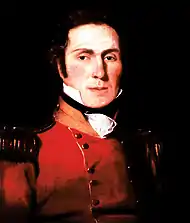
In 1824, the first convict colony was established at Redcliffe Point under Lieutenant Henry Miller. Meanwhile, Oxley and Allan Cunningham explored further up the Brisbane River in search of water, landing at the present location of North Quay. Only one year later, in 1825, the colony was moved south from Redcliffe to a peninsula on the Brisbane River, site of the present central business district, called "Meen-jin" by its Turrbal inhabitants.
At the end of 1825, the official population of Brisbane was "45 males and 2 females". Until 1859, when Queensland was separated from the state of New South Wales, the name Moreton Bay was used to describe the new settlement and surrounding areas. "Edenglassie" was the name first bestowed on the growing town by Chief Justice Francis Forbes,[7] a portmanteau of the two Scottish cities Edinburgh and Glasgow. The name soon fell out of favour with many residents and the current name in honour of Governor Thomas Brisbane was adopted instead.
The colony was originally established as a "prison within a prison"—a settlement, deliberately distant from Sydney, to which recidivist convicts could be sent as punishment. It soon garnered a reputation, along with Norfolk Island, as one of the harshest penal settlements in all of New South Wales. In July 1828 work began on the construction of the Commissariat Store. It remains intact today as a museum of the Royal Historical Society of Queensland and is only one of two convict era buildings still standing in Queensland. The other is The Old Windmill on Wickham Terrace.
Over twenty years, thousands of convicts passed through the penal colony. Hundreds of these fled the stern conditions and escaped into the bush. Although most escapes were unsuccessful or resulted in the escapees perishing in the bush, some (e.g. James Davis) succeeded in living as "wild white men" amongst the aboriginal people.
During these decades, the local aboriginals tried to "starve out" the settlement by destroying its crops—most notably their "corn fields" at today's South Bank. In retaliation, colony guards shot and killed aboriginals entering the corn fields.
Free settlement

As a penal colony, Brisbane did not permit the erection of private settlements nearby for many years. As the inflow of new convicts steadily declined, the population dropped. From the early 1830s the British government questioned the suitability of Brisbane as a penal colony. Allan Cunningham's discovery of a route to the fertile Darling Downs in 1828, the commercial pressure to develop a pastoral industry, and increasing reliance on Australian wool, as well as the expense of transporting goods from Sydney, were the major factors contributing to the opening of the region to free settlement.[8] In 1838, the area was opened up for free settlers, as distinct from convicts. An early group of Lutheran missionaries from Germany were granted land in what is now the north side suburb of Nundah.
In 1839 the first three surveyors, Dixon, Stapylton and Warner arrived in Moreton Bay to prepare the land for greater numbers of European settlers by compiling a trigonometrical survey.[9] From the 1840s, settlers took advantage of the abundance of timber in local forests. Once cleared, land was quickly utilized for grazing and other farming activities. The convict colony eventually closed.
The free settlers did not recognise local aboriginal ownership and were not required to provide compensation to the Turrbal aboriginals. Some serious affrays and conflicts ensued—most notably resistance activities of Yilbung, Dundalli, Ommuli, and others. Yilbung, in particular, sought to extract regular rents from the white population on which to sustain his people, whose resources had been heavily depleted by the settlers. By 1869, many of the Turrbal had died from gunshot or disease, but the Moreton Bay Courier makes frequent mention of local indigenous people who were working and living in the district. In fact, between the 1840s and 1860s, the settlement relied increasingly on goods obtained by trade with aboriginals—firewood, fish, crab, shellfish—and services they provided such as water-carrying, tree-cutting, fencing, ring-barking, stock work and ferrying. Some Turrbal escaped the region with the help of Thomas Petrie, who gave his name to the suburb of Petrie in the Moreton Bay region north of Brisbane.
Development in the early years of the colony of Queensland
On 6 September 1859, the Municipality of Brisbane was proclaimed. The next month, polling for the first council was conducted. John Petrie was elected the first mayor of Brisbane.[10] Queensland was formally established as a self-governing colony of Great Britain, separate from New South Wales, in 1859.

Unlike Sydney during the 1860s and 1870s, Brisbane had few professional artists and no art gallery.[11] Originally the neighbouring city of Ipswich was intended to be the capital of Queensland, but it proved to be too far inland to allow access by large ships, so Brisbane was chosen instead. The first jacaranda tree grown in Australia was planted at the City Botanic Gardens in 1864.[12]
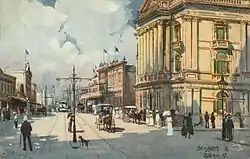
The 1893 Black February floods caused severe flooding in the region and devastated the city. Raging flood waters destroyed the first of several versions of the Victoria Bridge. Even though gold was discovered north of Brisbane, around Maryborough and Gympie, most of the proceeds went south to Sydney and Melbourne. The city remained an underdeveloped regional outpost, with comparatively little of the classical Victorian architecture that characterized southern cities.
A demonstration of electric lighting of lamp posts along Queen Street in 1882 was the first recorded use of electricity for public purposes in the world.[13] The first railway in Brisbane was built in 1879, when the line from the western interior was extended from Ipswich to Roma Street Station. First horse-drawn, then electric trams operated in Brisbane from 1885 until 1969.
In 1887, the Yungaba Immigration Centre was established at Kangaroo Point. The two-storey brick building is listed on the Queensland Heritage Register.[14]
The Local Authorities Act 1902 introduced the ability of a town to be designated a city with Brisbane being officially designated as one of the first three cities by the Act (the others being Rockhampton and Townsville).[15]
Tramway employees stood down for wearing union badges on 18 January 1912 sparked Australia's first General strike, the 1912 Brisbane General Strike which lasted for five weeks. The first ceremony to honour the fallen soldiers at Gallipoli was held at St John's Cathedral on 10 June 1915.[16] The tradition would later grow into the popular Anzac Day ceremony.
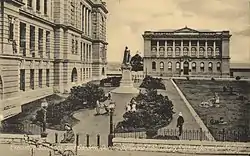
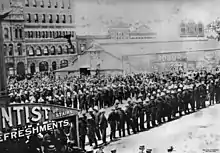
In an effort to prevent overcrowding and control urban development, the Parliament of Queensland passed the Undue Subdivision of Land Prevention Act 1885, preventing congestion in Queensland cities relative to others in Australia. This legislation, in addition to the construction of efficient public transport in the form of steam trains and electric trams, encouraged urban sprawl. Although the initial tram routes reached out into established suburbs such as West End, Fortitude Valley, New Farm, and Newstead, later extensions and new routes encouraged housing developments in new suburbs, such as the western side of Toowong, Paddington, Ashgrove, Kelvin Grove and Coorparoo.
This pattern of development continued through to the 1950s, with later extensions encouraging new developments around Stafford, Camp Hill, Chermside, Enoggera and Mount Gravatt. Generally, these new train lines linked established communities, although the Mitchelton line (later extended to Dayboro) and before being cut back to Ferny Grove) did encourage suburban development out as far as Keperra.
Subsequently, as private motor cars became affordable, land between tram and train routes was developed for settlement, resulting in the construction of Ekibin, Tarragindi, Everton Park, Stafford Heights, and Wavell Heights.
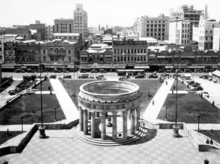
.jpg.webp)
Amalgamation of local government areas
In 1924, the City of Brisbane Act was passed by the Queensland Parliament, consolidating the City of Brisbane and the City of South Brisbane; the Towns of Hamilton, Ithaca, Sandgate, Toowong, Windsor, and Wynnum; and the Shires of Balmoral, Belmont, Coorparoo, Enoggera, Kedron, Moggill, Sherwood, Stephens, Taringa, Tingalpa, Toombul, and Yeerongpilly to form the current City of Greater Brisbane, now known simply as the City of Brisbane, in 1925.
To accommodate the new, enlarged city council, the current Brisbane City Hall was opened in 1930. Many former shire and town halls were then remodelled into public libraries, becoming the nucleus of Greater Brisbane's branch system. During the Great Depression, a number of major projects were undertaken to provide work for the unemployed, including the construction of the William Jolly Bridge and the Wynnum Wading Pool.
Brisbane during the Second World War
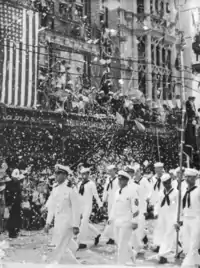
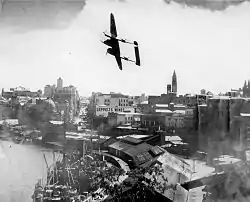
Due to Brisbane's proximity to the South West Pacific Area theatre of World War II, the city played a prominent role in the defence of Australia. The city became a temporary home to thousands of Australian and American servicemen. Buildings and institutions around Brisbane were given over to the housing of military personnel as required.
The present-day MacArthur Central building became the Pacific headquarters of U.S. General Douglas MacArthur,[17] and the University of Queensland campus at St Lucia was converted to a military barracks for the final three years of the war. St Laurence's College and Somerville House Girls' School in South Brisbane were also used by American forces.
During this time St Laurence's College was moved to Greenslopes to continue classes. Newstead House was also used to house American servicemen during the war. Because US authorities wanted separate recreational facilities black soldiers the Red Cross organised dances at the Doctor Carver Club in South Brisbane.[18]
Brisbane was used to mark the position of the "Brisbane Line", a controversial defence proposal allegedly formulated by the Menzies government, that would, upon a land invasion of Australia, surrender the entire northern part of the country. The line was, allegedly, at a latitude just north of Brisbane and spanned the entire width of the continent. Surviving from this period are several cement bunkers and gun forts in the northern suburbs of Brisbane and adjacent areas (Sunshine Coast/ Moreton Bay islands).
On 26 November and 27 November 1942, rioting broke out between US and Australian servicemen stationed in Brisbane. By the time the violence had been quelled one Australian soldier was dead, and hundreds of Australian and US servicemen were injured along with civilians caught up in the fighting.[19] Hundreds of soldiers were involved in the rioting on both sides. This incident, which was heavily censored at the time and apparently was not reported in the US at all, is known as the Battle of Brisbane.
Post-War Brisbane
Immediately after the war, the Brisbane City Council, along with most governments in Australia, found it difficult to raise finances for much-needed repairs and development. Even where funds could be obtained materials were scarce. Adding to these difficulties was the political environment encouraged by some aldermen, led by Archibald Tait, to reduce the city's rates (land taxes). Ald Tait successfully ran on a slogan of "Vote for Tait, he'll lower the rate." Rates were indeed lowered, exacerbating Brisbane's financial difficulties.
Although Brisbane's tram system continued to be expanded, roads and streets remained unsealed. Water supply was limited, although the City Council built and subsequently raised the level of the Somerset Dam on the Stanley River. Despite this, most residences continued to rely heavily on rainwater stored in tanks.
The limited water supply and lack of funding also meant that despite the rapid increase in the city's population, little work was done to upgrade the city's sewage collection, which continued to rely on the collection of nightsoil. Other than the CBD and the innermost suburbs, Brisbane was a city of "thunderboxes" (outhouses) or of septic tanks.
What finances could be garnered by the Council were poured into the construction of Tennyson Powerhouse, and the extension and upgrading of the powerhouse in New Farm Park to meet the growing demands for electricity. Brisbane's first modern apartment building, Torbreck at Highgate Hill, was completed in 1960.[20]
Work continued slowly on the development of a town plan, hampered by the lack of experienced staff and a continual need to play "catch-up" with rapid development. The first town plan was adopted in 1965.[21]
1961 saw the election of Clem Jones as Lord Mayor. Ald Jones, together with the town clerk J.C. Slaughter sought to fix the long-term problems besetting the city. Together they found cost-cutting ways to fix some problems. For example, new sewers were laid 4 feet deep and in footpaths, rather than 6 feet deep and under roads. In the short term, "pocket" or local sewerage treatment plants were established around the city in various suburbs to avoid the expense of developing a major treatment plants and major connecting sewers.
They were also fortunate in that finance was becoming less difficult to raise and the city's rating base had by the 1960s significantly grown, to the point where revenue streams were sufficient to absorb the considerable capital outlays.
Under Jones' leadership, the City Council's transport policy shifted significantly. The City Council hired American transport consultants Wilbur Smith to devise a new transport plan for the city.[22] They produced a report known as the Wilbur Smith "Brisbane Transportation Study" which was published in 1965. It recommended the closure of most suburban railway lines, closure of the tram and trolley-bus networks, and the construction of a massive network of freeways through the city. Under this plan the suburb of Woolloongabba would have been almost completely obliterated by a vast interchange of three major freeways.
Although the trams and trolley-buses were rapidly eliminated between 1968 and 1969, only one freeway was constructed, the trains were retained and subsequently electrified. The first train line to be so upgraded was the Ferny Grove to Oxley line in 1979. The train line to Cleveland, which had been cut back to Lota in 1960, was also reopened.
Brisbane floods
Brisbane has been inundated by severe floods of the Brisbane River in 1864, 1893, 1897, 1974, 2011 and 2013. A comprehensive flood mitigation scheme was instituted for the Brisbane River catchment area in the aftermath of the 1974 flood. Since then the city remained largely flood free, until the floods in January 2011 and 2013 floods.
1980s
.jpg.webp)
Brisbane hosted the Commonwealth Games in 1982 and the World's Fair in 1988. Between the late 1970s and mid-1980s, Brisbane was the focus of early land rights protests (e.g. during the Commonwealth Games) and several well-remembered clashes between students, union workers, police and the then-Queensland government. Partly from this context, innovative Brisbane music groups emerged (notably Punk groups) that added to the city's renown.
Later in that decade, emission control regulation had a major effect on improving the city's air quality. The banning of backyard incinerators in 1987, together with the closure of two local coal fired power stations in 1986 and a 50% decrease in lead levels found in petrol, resulted in a lowering of pollution levels. Brisbane's population growth far exceeded the national average in the last two decades of the 20th century, with a high level of interstate migration from Victoria and New South Wales.
21st century
After three decades of record population growth, Brisbane was hit again by a major flood in January 2011. The Brisbane River did not reach the same height as the previous 1974 flood, but still caused extensive damage and disruption to the city.[23][24]
Brisbane also hosted major international events including the final Goodwill Games in 2001, the Rugby League World Cup Final in 2008 and again in 2017, as well as the 2014 G20 Brisbane summit.
Population grown has continued to be among the highest of the Australian capital cities in the first two decades of the 21st century, and major infrastructure including the Howard Smith Wharves, Roma Street Parklands, Queens Wharf, the Brisbane Riverwalk, the Queen's Wharf casino and resort precinct, the Brisbane International Cruise Terminal, the Clem Jones, Airport Link, and Legacy Way road tunnels, and the Airport, Springfield, Redcliffe Peninsula and Cross River Rail railway lines have been completed or are under construction.
See also
References
- Draft Design Report: Chapter 15. Aboriginal Cultural Heritage (PDF). Brisbane: Brisbane Metro. 2018. p. 3.
- Jones, Ryan. "Indigenous Aboriginal Sites of Southside Brisbane | Mapping Brisbane History". mappingbrisbanehistory.com.au. Retrieved 25 August 2020.
- Kerkhove, Ray (2015). Aboriginal Campsites of Greater Brisbane: An Historical Guide. Salibury: Boolarong Press.
- "The Life of Captain Matthew Flinders". Archived from the original on 4 December 2008. Retrieved 30 October 2008.
- "Port Bowen (entry 7456)". Queensland Place Names. Queensland Government. Retrieved 30 March 2015.
- Field's New South Wales p. 89 (published 1925) Archived 20 August 2008 at the Wayback Machine see footnote
- Seeing South-East Queensland (2 ed.). RACQ. 1980. p. 7. ISBN 0-909518-07-6.
- Laverty, John (2009). The Making of a Metropolis: Brisbane 1823–1925. Salisbury, Queensland: Boolarong Press. pp. 2–3. ISBN 978-0-9751793-5-2.
- "First surveys". History of Mapping and Surveying. Department of Natural Resources and Mines, Queensland Government. Archived from the original on 23 April 2013. Retrieved 27 September 2013.
- Laverty, John (1974). "Petrie, John (1822–1892)". Australian Dictionary of Biography. Melbourne University Press. ISSN 1833-7538. Retrieved 8 November 2011 – via National Centre of Biography, Australian National University.
- de Vries, Susanna; Jake de Vries (2003). Historic Brisbane: Convict Settlement to River City. Brisbane, Australia: Pandanus Press. p. 118. ISBN 0-9585408-4-5.
- Jessica Hinchliffe (1 November 2017). "Why Brisbane, not Grafton, is the original jacaranda capital of Australia". ABC News. Australian Broadcasting Corporation. Archived from the original on 2 November 2017. Retrieved 1 November 2017.
- Dunn, Col (1985). The History of Electricity in Queensland. Bundaberg: Col Dunn. p. 21. ISBN 0-9589229-0-X.
- "Yungaba Immigration Depot (entry 600245)". Queensland Heritage Register. Queensland Heritage Council. Retrieved 13 July 2015.
- "Local Authorities Act of 1902 (2 Edw VII, No 19)". Queensland Historical Acts. Australasian Legal Information Institute. pp. 8366–8367. Retrieved 4 November 2018.
- Tony Moore (16 July 2013). "Push to remember Brisbane clergyman's role in Anzac history". Brisbane Times. Fairfax Media. Archived from the original on 18 July 2013. Retrieved 19 July 2013.
- Dunn, Peter. "General Headquarters (GHQ) – South West Pacific Area: AMP Building, corner of Queen and Edward Streets, Brisbane". Oz at War. Archived from the original on 19 January 2013. Retrieved 18 April 2015.
- Damousi, Joy; Marilyn Lake (1995). Gender and War: Australians at War in the Twentieth Century. CUP Archive. p. 185. ISBN 0521457106. Archived from the original on 30 August 2017. Retrieved 30 August 2017.
- Dunn, Peter. "The Battle of Brisbane – 26 & 27 November 1942". Oz at War. Archived from the original on 15 April 2015. Retrieved 18 April 2015.
- McBride, Frank; et al. (2009). Brisbane 150 Stories. Brisbane City Council Publication. p. 226. ISBN 978-1-876091-60-6.
- "Fact sheet 16. Development Assessment". Brisbane City Plan 2014. Brisbane City Council. Archived from the original on 30 August 2017. Retrieved 30 August 2017.
- Allan Krosch (9 March 2009). "History of Brisbane's Major Arterial Roads: A Main Roads Perspective Part 1" (PDF). Queensland Roads, Edition 7. Department of Transport and Main Roads. Archived from the original (PDF) on 7 April 2012. Retrieved 5 November 2011.
- Berry, Petrina (13 January 2011). "Brisbane braces for flood peak as Queensland's flood crisis continues". The Courier-Mail. Archived from the original on 16 August 2011. Retrieved 14 January 2011.
- "Before and after photos of the floods in Brisbane". Abc.net.au. Archived from the original on 12 July 2011. Retrieved 4 November 2012.
Further reading
- J. R. Cole, Shaping a City: Greater Brisbane 1925–1985, Brisbane 1984
- G. Greenwood and J. Laverty, Brisbane 1859–1959, BCC, 1959
- J. G. Steele (1975). Brisbane Town in convict days, 1824–1842. University of Queensland Press. ISBN 0702209252.
External links
| Wikimedia Commons has media related to History of Brisbane. |
- Australian Heritage Historical Towns Directory: Brisbane
- Brisbane Tramway Museum
- The Home Front – World War 2
- Brisbane’s role in WWII focus of new book regarding Brisbane as a large submarine base in World War II
- State Library of Queensland
- Google map of Pre 1925 merger Brisbane Councils
